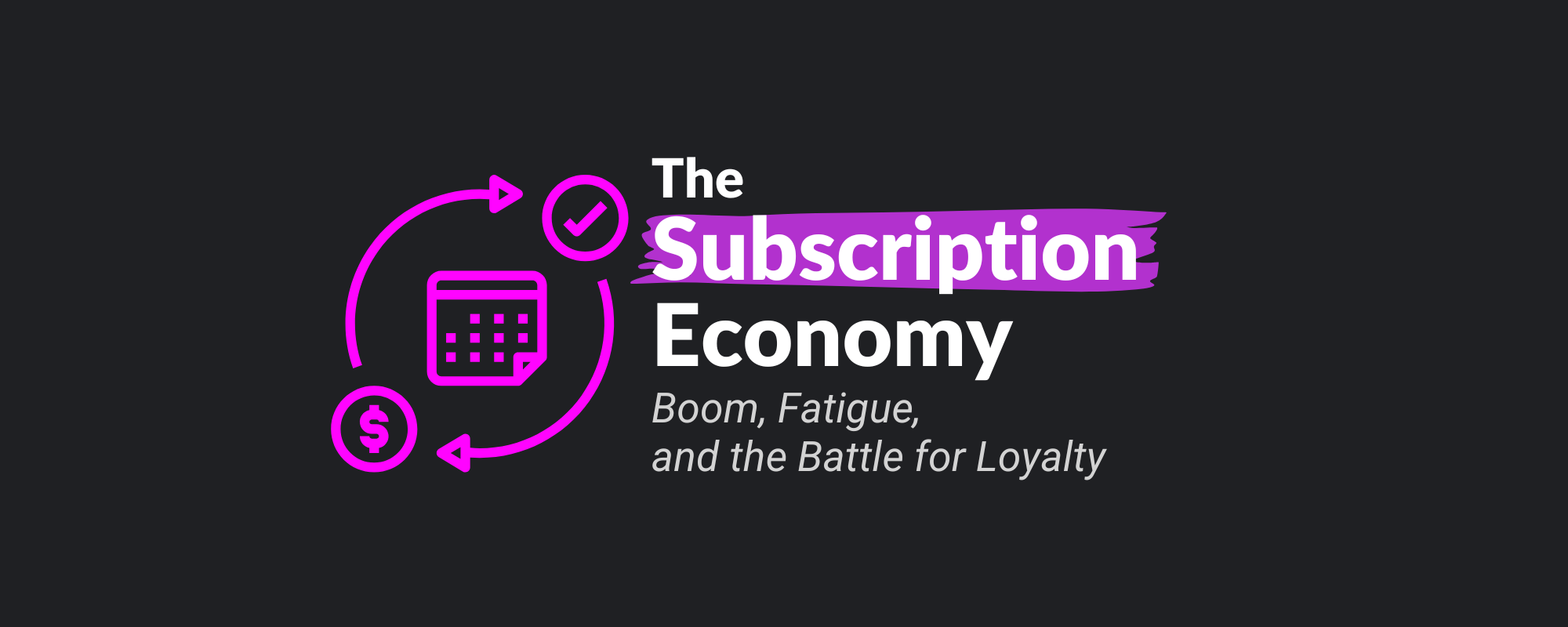The Subscription Economy: Boom, Fatigue, and the Battle for Loyalty

Remember when subscriptions were simple? You subscribed to your favorite magazine, received it monthly, and that was that. Maybe it made its way into a pile on your coffee table. Today, though? It’s not a magazine or two—it’s video streaming, music, fitness apps, grocery services, lifestyle boxes, software tools, and the list goes on. We've moved from a few dollars a month to a complicated web of endless recurring charges that sneak up at midnight like gremlins stealing a piece of your salary. Welcome to the age of subscription everything, where convenience comes at the cost of clutter.
This isn't a takedown of subscriptions, nor a celebration of their dominance. It’s a deep dive into the digital “subscription-everything” culture—an exploration of its meteoric rise, signs of saturation, and, most importantly, what this means for the consumer who’s caught in the middle of this all-you-can-eat buffet. Spoiler alert: It’s starting to feel like a meal where we might’ve overestimated our appetite.
The Golden Age of Subscriptions
Subscriptions first started charming us when they promised value and exclusivity. Who could resist Netflix's early promise of unlimited movies for a fraction of the cost of cable? Or Adobe Creative Cloud, where instead of shelling out a small fortune upfront, creatives could spread the cost across manageable monthly payments? Subscription models swept through every industry like a cool breeze—making things accessible, affordable, and even a bit luxurious. Imagine getting a monthly delivery of gourmet coffee or other exclusive specialty treats straight to your door—luxury on a budget!
But the attraction wasn't just in what you got; it was in how it felt. The thrill of being “in”—having that membership or subscription badge—made us feel special. This wasn’t just a business model; it was the redefinition of modern convenience, one monthly bill at a time.
And oh boy, did we fall for it. According to SubsBase, the global subscription economy is expected to reach $1.5 trillion by 2025[1]. We’re in deep, and there’s no denying that subscriptions have offered us immense convenience. They gave us a simple solution to access software, watch shows, get fit, learn languages, and even get our coffee—one less decision in an otherwise chaotic world.
The Cracks Are Showing
But let’s talk about the dark side of convenience. What started as a lean, agile solution to accessing services has turned into a bloated ecosystem of memberships and recurring fees. It's the dreaded “subscription fatigue.” The fact that 47% of consumers believe they’re paying for subscriptions they no longer use[2] reveals a truth: people are drowning in an overload of memberships they either don’t use or don’t even remember they subscribed to.
If you think it’s just a Western trend, think again. In the Middle East, particularly in the UAE and KSA, digital subscriptions are on the rise. But so is the fatigue. Streaming services in the Middle East grew by 24% in 2022[3], and while we can see the enthusiasm, there’s also a growing hesitation. How many services do you really need to keep up with your favorite content? It turns out that too many choices might be less of a luxury and more of a burden. It feels like we’ve moved from a subscription model to a “choose-your-subscription-overlord” challenge.
Take Netflix’s loss of 970,000 subscribers in Q2 of 2022[4]. Even the mighty can falter, yes I know it's because Covid "disappeared", but still, almost a million subscribers signed-out in a couple of months! Consumers are becoming savvy; they’re cutting back, calculating what’s actually valuable to them. In Australia, nearly 45% of respondents said they'd be willing to cancel an existing subscription and trade it for a new one[5]. It’s not disloyalty—it’s survival.
Marketers in a Saturated World
So where does this leave marketers? You might think that consumer churn is a challenge—but if you squint, it’s also an opportunity. This is the moment for smart marketers to dig deep. It’s no longer just about acquisition; it’s about retention. How do you keep your subscribers engaged when they have 15 other services that promise them similar—if not better—experiences?
Retention is now the battleground, and the rules have changed. Brands must deliver not only consistently good experiences but also innovative incentives. Again, let's take Netflix as an example: their decision to introduce ad-supported tiers in some markets isn’t merely about making more money; it’s about hooking in potential subscribers by lowering the entry barrier. Want in, but don’t want to pay? Sure, start with ads—eventually, we’ll convert you. It’s the ultimate game of "let’s lower the walls and see if you’re willing to stay for the party." And if you do, maybe we’ll serve you better hors d'oeuvres later.
Businesses also need to rethink how they’re engaging with subscribers. It’s not enough to offer a bundle—personalization is key. People are tired of "one-size-fits-all." Lisa Jaeger at Simon-Kucher recently put it aptly: “Providers are fighting for the time and budgets of consumers. Cancellations will become more likely unless service providers can prove the value of their product”[6]. You must not only promise value but show it, consistently.
The UAE and KSA markets are prime examples. Consumers here are discerning, and while there’s a hunger for innovation, there’s a critical eye that evaluates whether the value is indeed there. It’s no longer enough to be shiny and new—you’ve got to be smart and necessary. Think about Shahid and StarzPlay, leading localized offerings in the region. It’s not just about getting the best content; it’s about speaking directly to a culture. That’s how you stay relevant.
Subscription Fatigue—The Consumer’s Perspective
Here’s a scenario: It’s the end of the month. You’re going through your bank statements, and somewhere between “Organic Pet Food Subscription” and “Luxury Coffee Box,” you start to feel a little… suffocated. It’s ironic, right? The same services that were meant to save you time and offer convenience now eat away at your peace of mind and wallet. It’s not just decision fatigue—it’s also financial fatigue. And consumers are waking up to it.
The subscription, membership, and loyalty sector in the MENA region is valued at $3 trillion in 2024, up from $2 trillion in 2023[7]. But with such high value comes a higher level of scrutiny. Consumers are increasingly choosing what subscriptions are actually worth their hard-earned money. The battle isn’t just about who can grab the subscriber’s attention; it’s about who can hold onto it for longer. Loyalty isn’t given freely anymore—it’s bought with value, personalization, and authenticity.
Financial constraints and perceived lack of value are becoming primary reasons for cancellations. And let's face it, that’s fair. Why pay for a fitness app subscription when you've barely made it off the couch in weeks? Why keep subscribing to a language learning app when all you’ve learned to say is “Where’s the bathroom?” And is it worth having three different video subscriptions when you’re only watching Seinfeld reruns? The value must be clear, and more importantly, it must be felt.
The Future of Subscriptions—Where Do We Go From Here?
So where does this leave the subscription economy? We’re at an inflection point, and the answer lies not in "more subscriptions," but "better subscriptions." The future will be shaped by those willing to adapt. Hybrid models are a potential path forward: consider offering perks alongside one-time purchases—imagine buying a new fitness bike and getting a free subscription to live classes for a year. The goal here is not just to sell a product or service but to cultivate a relationship.
AI is also reshaping the subscription landscape, improving customer experiences, predicting churn, and personalizing services. AI is, essentially, the butler who remembers how you like your coffee and makes sure your favorite seat is always available. But it’s only useful if it's not intrusive. As consumers, we’ve gotten savvier, and we can spot when a brand is trying a bit too hard to make itself feel necessary.
The Middle East is no stranger to innovation, and the region’s take on subscriptions will likely lean towards highly localized, culturally in-tune offerings. There’s also an emerging interest in direct mobile billing—think about the ease of having your favorite content charged directly through your telecom provider. It’s seamless, smart, and most importantly, keeps the experience simple. And simplicity, it turns out, is the antidote to subscription fatigue.
Are We Subscribed to Saturation?
We are at a crucial juncture. The subscription economy is not slowing down—it’s evolving. Consumers are no longer interested in more of the same. They want authentic experiences, they want services that understand them, and they want brands to work a little harder for their attention and loyalty. It’s time for businesses to move past “monthly billing” and get back to the true essence of what subscriptions once promised: value, convenience, and maybe even a bit of joy.
And for us—the consumers—maybe it’s time we did a little introspection too. Maybe it’s time to reconsider that premium water subscription (just get a filter), or the box of artisanal tea (how much artisanal tea does one person need?), and instead, put our energy and money into subscriptions that add genuine value. Because at the end of the day, what we really crave isn’t just access—it’s meaning. And if a subscription isn’t bringing that to the table, well, maybe it’s time to let it simmer a bit longer, or even toss it out and cook up something that truly satisfies.
[1] SubsBase Insights. "Riding the Wave: The Subscription Economy's Rise in the Middle East." Retrieved from: https://subsbase.com/insights/riding-the-wave-the-subscription-economys-rise-in-the-middle-easttrends-and-opportunities-2025
[2] West Monroe Partners. "The State of Subscription Services Spending." Retrieved from: https://www.westmonroe.com/perspectives/report/the-state-of-subscription-services-spending
[3] Digital TV Research. "Middle East Streaming Growth in 2022." Retrieved from: https://www.digitaltvresearch.com/
[4] Netflix Earnings Report. Retrieved from: https://ir.netflix.net/
[5] Consultancy Australia. "Streaming Services Growth Slows as Subscription Fatigue Spreads." Retrieved from: https://www.consultancy.com.au/news/8117/streaming-services-growth-slows-as-subscription-fatigue-spreads
[6] Consultancy Australia. "Streaming Services Growth Slows as Subscription Fatigue Spreads." Retrieved from: https://www.consultancy.com.au/news/8117/streaming-services-growth-slows-as-subscription-fatigue-spreads
[7] SUBTA. "2024 State of Subscription Commerce." Retrieved from: https://subta.com/2024-state-of-subscription-commerce-comprehensive-insights-and-trends/



Discussion